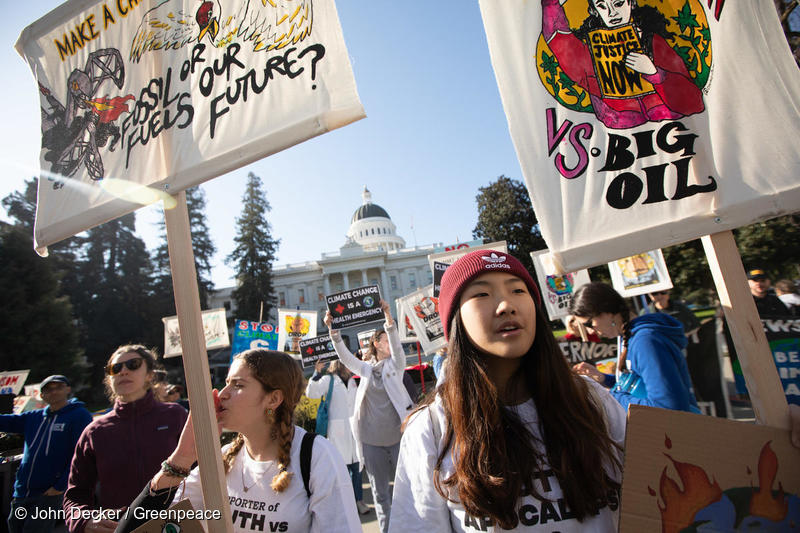California’s Oil Industry Spends Millions to Qualify Referendum to Undo Public health buffer zone between drilling and homes
California’s Oil Industry Spends Millions to Qualify Referendum to Undo Public health buffer zone between drilling and homes

Last fall – after a decade of campaigning for protections for people living near oil drilling – California frontline communities and environmental justice groups, alongside Greenpeace USA and our supporters, won a momentous victory. But today, California’s oil industry has managed to put that progress on hold.
In September 2022, Governor Newsom signed Senate Bill 1137 into law – legislation that enacted a 3,200-foot public health and safety setback, or buffer zone, to protect sensitive sites, like homes and schools, from the toxic emissions associated with oil and gas extraction. Today, the law has been paused after being in effect for less than a month. Just days after SB 1137 was signed into law, California oil and gas producers launched a petition drive for a referendum to repeal this law. After dedicating more than $20 million for paid signature gathering, on February 3, 2023, the referendum officially qualified to appear before voters on the 2024 ballot. This referendum accomplishes two things: it immediately pauses the implementation of the oil and gas setback and it forces voters to vote on whether or not this commonsense public health protection should become law.
This sounds democratic, right? But in reality, all too often, big industries can successfully pause and even undo popular policy changes simply by dumping money misleading and dividing Californians. In fact, many Californians have already filed formal complaints of misinformation and voter fraud in response to the oil industry’s signature gathering tactics. That’s because not only do the overwhelming majority of Californians support setbacks – we also have science on our side.
Doctors and scientists have known for years that oil and gas wells emit toxic pollution that negatively impacts everyone nearby. Living, working, or going to school near oil and gas drilling is linked to a host of harmful health impacts including asthma, respiratory diseases, preterm births, and even cancer. Recent studies also indicate a higher risk of severe complications from COVID-19. Public health experts have recommended 3,200 feet as the minimum safe distance between neighborhoods and drilling. The science is clear; the public health threat is urgent. Yet, communities living near drilling are still breathing toxic air day in and day out.
In California, more than 2.7 million people live within 3,200 feet of an oil or gas well. Most of them are Black, Latinx, Indigenous, Asian immigrants, and working class. Many more Californians work near these wells, both in the oil industry itself and at schools, healthcare facilities, and countless other professions.
Californians can use this mapping tool to identify how close they live and work to toxic drilling.
For more than a decade, frontline communities and environmental justice organizations campaigned to establish a buffer zone (or ‘setback’) between where this harmful drilling can take place relative to locations like homes, schools, and playgrounds. This fight reached a peak in the summer of 2022 when Governor Newsom announced a package of last minute climate bills, including SB 1137, a bill to establish a 3,200-foot oil and gas drilling setback.
Despite intense lobbying by California’s oil and gas interests, who had successfully killed two previous setback bills, SB 1137 passed the California State Legislature on August 31, 2022 and was signed into law by Governor Newsom days later. This victory was led by VISIÓN – a coalition of environmental justice organizations and frontline communities and was buoyed by a massive coalition of California organizations, including Greenpeace USA and our supporters.
SB 1137 promised to usher in a safer and healthier future for millions of Californians by preventing new oil wells within 3,200 feet of communities and mandating robust pollution control measures for all existing wells. Given that about 25% of oil production in California comes from within the setback distance, SB 1137 also marked an important step in the governor’s commitment to move California beyond oil. But because the fossil fuel industry is hell-bent on maintaining its stranglehold on our democracy all in the name of its profits, these common sense health protections could be stripped away entirely.
A cleaner, healthier, and more prosperous future will now be on California’s 2024 ballot. And winning this ballot measure is imperative not only for the future success of environmental legislation in the California Legislature, but also to hold the line against the oil and gas industry’s dirty tactics that will grow as more progress is made toward phasing out fossil fuels. This referendum is but a glimpse into Big Oil’s future playbook to slow inevitable progress at all costs.
This 2024 ballot measure is a massive threat to environmental and climate justice, and it means we must build bridges, unite causes, and demonstrate the people power we need to win the kind of climate action that both science and justice demand.
The good news is there is something we can do today to prevent Big Oil from turning back the clock on basic health protections for frontline communities. Governor Newsom already has the authority to stop neighborhood drilling – in fact, more than three years ago, he directed his agency CalGEM (California Geologic Energy Management Division) to issue protections for communities living near drilling through a public health rulemaking process. We need our leaders to act urgently to speed up this stalled process. Governor Newsom must act now to expedite the rulemaking process and permanently establish a buffer zone between communities and drilling. In the meantime, he must issue an emergency rule to prevent any new drilling within 3,200 feet of communities.
